

Log In ‹ Wordpress for ISS Students and Staff. WordPress Portfolio template (to be used by students G9-12) Wordpress Tutorial - Google Slides. The Types of Portfolios. 10 Tips for Embedding Digital Portfolios as Part of your Classroom Habits – A Guide to Documenting Learning. Teachers and schools are dipping their toes into the world of Digital Portfolios.
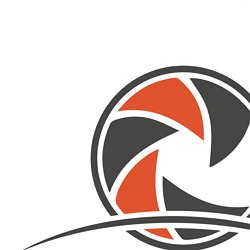
They are using platforms such as edublogs, Blogger, SeeSaw, Bloomz or Google Sites, to document and archive student work. BUT….the simple act of having digital portfolios for your students doesn’t necessarily mean they are working. Digital Portfolios . . . Making the Learning Visible – Teaching and Learning With Heart. As promised, here is my second post about Making Learning Visible and Digital Portfolios . . .
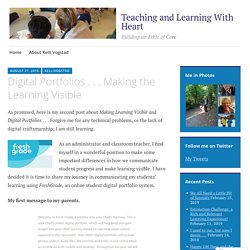
Forgive me for any technical problems, or the lack of digital craftsmanship; I am still learning. As an administrator and classroom teacher, I find myself in a wonderful position to make some important differences in how we communicate student progress and make learning visible. I have decided it is time to share my journey in communicating my students’ learning using FreshGrade, an online student digital portfolio system. My first message to my parents. As I reflect back on the year, it has been a journey of careful decision-making, exploring, and celebrating. Pedagogical Documentation When I began teaching in the early 80’s, the ideas behind the pedagogical documentation developed by the preschool educators of Reggio Emilia in northern Italy inspired many teachers who valued and understood the importance of making learning visible. A New Kind of Digital Documentation The Teacher’s Role Like this:
Digital Portfolios and Content. Schools, teachers and learners struggle with challenges in many shapes and forms when it comes to digital portfolios.
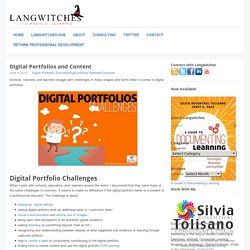
When I work with schools, educators, and learners around the world, I discovered that they have many of the same challenges in common. What’s the Difference Between Displaying and Documenting Learning? - Corwin Connect. Before I answer this question, I will ask another: Do you have a social media account that allows you to snap and share photos and/or videos, as well as send messages (e.g., Facebook, Instagram, Twitter)?
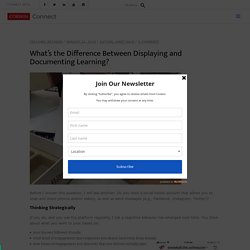
Thinking Strategically If you do, and you use the platform regularly, I bet a cognitive behavior has emerged over time. You think about what you want to post based on: Let me explain what I mean using my puppy as an example. Snowball started her Instagram account (snowball.the.schnauzer) when she moved into our furever home. What about the What? Finding the Deeper Meaning in Pedagogical Documentation. By: Diane Kashin, Ed.D, RECE.
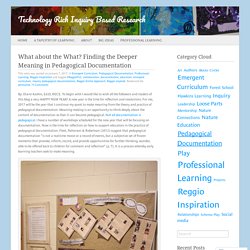
To begin with I would like to wish all the followers and readers of this blog a very HAPPY NEW YEAR! A new year is the time for reflection and resolutions. For me, 2017 will be the year that I continue my quest to make meaning from the theory and practice of pedagogical documentation. Meaning making is an opportunity to think deeply about the content of documentation so that it can become pedagogical.
10 Tips For Making Your Blog Posts Easier To Read. Dear blogger,You have such wonderful ideas to share!
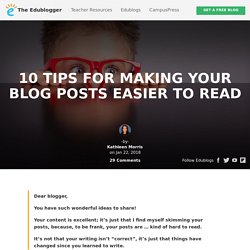
Your content is excellent; it’s just that I find myself skimming your posts, because, to be frank, your posts are … kind of hard to read.It’s not that your writing isn’t “correct”, it’s just that things have changed since you learned to write.In fact, it might be time to forget a lot of what you learned about writing at school.Can we chat about making your blog posts easier to read? With thanks, A hopeful reader Getting a blog post together isn’t easy, is it? You have to put all the distractions on your computer aside and focus on one task: tapping away at the keyboard and organizing all your thoughts until your post takes shape. So, of course, you want people to actually read your post. There are many personal benefits to simply writing too. Why portfolios.
Process. 100 Questions That Help Students Think About Thinking - 100 Questions That Help Students Think About Thinking by Terry Heick.
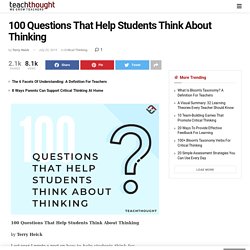
40ReflectionQuestions. The Reflective Student: A Taxonomy of Reflection (Part 2) – Copy / Paste by Peter Pappas. Reflective student Reflection can be a challenging endeavor.
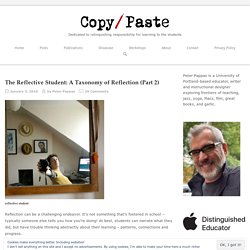
It’s not something that’s fostered in school – typically someone else tells you how you’re doing! At best, students can narrate what they did, but have trouble thinking abstractly about their learning – patterns, connections and progress. In an effort to help schools become more reflective learning environments, I’ve developed this “Taxonomy of Reflection” – modeled on Bloom’s approach. A Simple Trick for Success with One-Pagers. Wanna Know If Students Are Learning? Ask Them These 4 Questions. It can be a struggle to best help students understand what they are learning or for students to articulate their learning in meaningful ways.
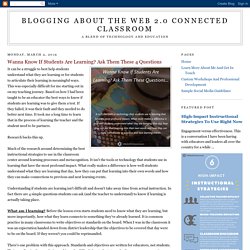
This was especially difficult for me starting out in on my teaching journey. Based on how I had been taught to be an educator the best ways to know if students are learning was to give them a test. If they failed, it was their fault and they needed to do better next time. It took me a long time to learn that in the process of learning the teacher and the student need to be partners.
Research backs this up. Much of the research around determining the best instructional strategies to use in the classroom center around learning processes and metacognition. Understanding if students are learning isn't difficult and doesn't take away time from actual instruction. What am I learning? There's one problem with this approach. Teacher clarity aims to narrow the focus of learning. HookED SOLO Taxonomy in teaching and learning. A Taxonomy of Reflection: A Model for Critical Thinking. My approach to staff development (and teaching) borrows from the thinking of Donald Finkel who believed that teaching should be thought of as “providing experience, provoking reflection.”
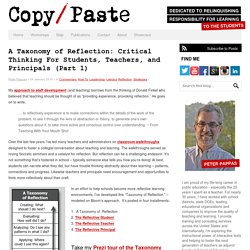
Digital Portfolios: The Art of Reflection. Too often, conversations about digital portfolios center on the tools: how to save, share, and publish student work. Mastering the technical component of digital portfolios is critical, and students do need an opportunity to showcase their work to a broader audience. However, when we let the process of curate > reflect > publish serve as the sole focal point, digital portfolios become summative in nature and are viewed as an add-on at the end of a unit, project, or activity.
Digital Portfolios: The Art of Reflection. A few weeks ago, I met with a group of educators to discuss their observations from a series of learning walks in classrooms. They found that though students could accurately tell them what they were doing, they struggled to articulate what they might be learning. In response, I suggested building reflection into the daily routine. A Project to Prompt Student Reflection in High School. Teachers think often about how best to provide students with feedback that helps them continue to learn. This past year, as I considered how to foster the skills my students would need for the following year, I created a new final project and built up new ways to provide feedback.
The Dream Job At Los Gatos High School, we have a four-year interdisciplinary pathway called LEAD@LG (Lead, Explore, Act, and Design at Los Gatos). I teach the ninth-grade English classes, and the students’ final project was to explore their dream job.